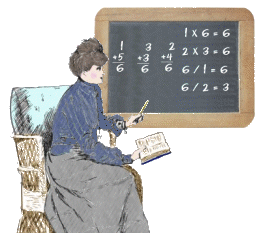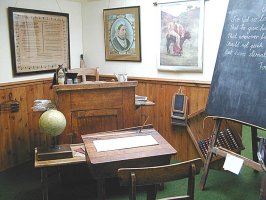I'm Miss Ellen Smith, and being the one who
assists the Ashton children with their lessons, it's only appropriate that I be the one to
begin the discussion on education during the  Victorian period.
Victorian period.
Prior to the 1870 Education Act, children in Victorian England were educated in many different ways, or not at all, depending upon their sex and their parents' financial situation, social class, religion and values.
The first schools of record, dating back to the 16th century, were Sunday schools. This type of school is often associated with Robert Raikes, a newspaper publisher, who popularized the idea. By the middle of the 19th century, approximately two thirds of all working class children between the ages of 5 and 15 were attending Sunday school.
Here in England, an elementary education isn't free. Schools were and continue to be financed by private individuals, churches, charitable organizations and businesses. One can expect to pay between one and nine pence per child per week. As a result of the Education Act things are beginning to change, and some schools are now able to obtain assistance through government grants.
 Unlike the classroom picture here (click for larger
image), the Victorian classroom was small, dark and warmed by a single stove or
open fire. The walls in most cases were bare, with the exception of an embroidered
text or blackboard. Students were taught the basics, reading, writing and
arithmetic. Females did not receive the same education as a male student as a female
would most certainly marry and raise a family. Classes would usually take place
between the hours of 9:00 A.M. - 12:30 P.M. and resume again at 2:00 P.M. until 4:30
P.M. Children who lived within a short walking distance usually went home for lunch;
the others brought their lunch and remained at school. (Picture courtesy of The Art and Museum Service, East
Sussex County Council, England--a very special thank you.)
Unlike the classroom picture here (click for larger
image), the Victorian classroom was small, dark and warmed by a single stove or
open fire. The walls in most cases were bare, with the exception of an embroidered
text or blackboard. Students were taught the basics, reading, writing and
arithmetic. Females did not receive the same education as a male student as a female
would most certainly marry and raise a family. Classes would usually take place
between the hours of 9:00 A.M. - 12:30 P.M. and resume again at 2:00 P.M. until 4:30
P.M. Children who lived within a short walking distance usually went home for lunch;
the others brought their lunch and remained at school. (Picture courtesy of The Art and Museum Service, East
Sussex County Council, England--a very special thank you.)
The other schools from which the National State Education System evolved included the British Schools, National Schools, Ragged Schools Dame Schools, Workhouse Schools, Industrial and District Schools and are described briefly in the next section.
Back to Intro/Index or Site Map
| | Family Gallery | Servants Parlour | Tour Home | Typical Day | Etiquette | Shopping Trip | |
| | Victorian Christmas | Victorian England Fun and Games | Ashton Library | Victorian Wedding | |
| | Victorian England Overview | Guest Registry | Honorary Victorian | Tours | |
| | Awards Received | Bibliography | |
| | 1876 Victorian England Home | |
Credits below copyright information |
| Contact
webmaster |
| Copyright
1999-2017 All Rights Reserved - B. Malheiro May not be reproduced in any way without express written permission of webmaster. |
Credits:
Background set, buttons and teacher are the creation of B. Malheiro, for this site only. All content researched and written by B. Malheiro. The picture link, The Art and Museum Service, East Sussex County Council, England, has been removed due to their site revision and material no longer being shown.